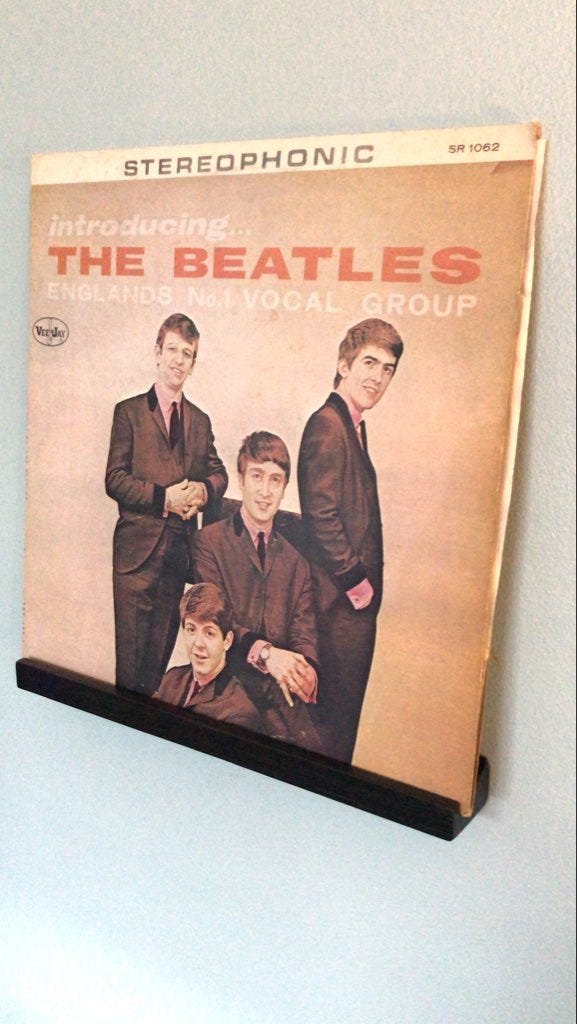The 12 Newsletter Items of Christmas
No to partridges and French hens. Yes to Christmas tree hating senators, mothballed Airbuses, Twitter confusion, and counterfeit Beatles albums.
Want to read stories like this sooner? Subscribe to the North Carolina Rabbit Hole for free.
1. Hatin’ on Trees
It’s Christmas Eve, so it’s time to revisit two Christmas stories that I’ve been lucky enough to tell. The first? A little ditty about Richard Stevens, who was the ONLY state senator to vote against making the Fraser fir the official Christmas tree of North Carolina. It was nothing personal. So he says.
2. Balls
The second: The story of Marshall Rauch, the Jewish man from Gastonia who was once the world’s largest maker of Christmas ornaments. The humor in that is not lost on Rauch, who has been telling jokes about it for more than a half-century. His go-to: “All my friends used to tease me. ‘How do you feel about making ornaments for a Christian religion?’ I said I have no problem. One of our guys started Christianity.”
Rauch loves to tell light-hearted jokes, although some of them are more risque, mostly because Rauch refers to his ornaments as balls. Hence, this one did not make the cut for my PG-rated magazine and podcast: “It’s a unique and different business. It’s put me in a position to say that more women in the world have handled my balls than anybody else.”
Rauch is now 97, and still giving interviews.
Balls.
3. Listen Local
Man-about-town and Our State colleague Mark Kemp has come up with a Spotify playlist of 23 North Carolina-bred Christmas songs, featuring everything from Andy Griffith (he sings!) to Anthony Hamilton.
4. C’mon and Lathe Up
Legendary Raleighite Petey Pablo does not have a Christmas song, but he does make his own furniture. North Caroliiiiina, c’mon and raise up, get some Charmin, twist it round yo hand, see this toilet paper holder:
Petey Pablo, call Mike Easley and go on The Woodwright’s Shop.
5. Greensboro’s Jet Plane Parking Lot
For months now, I’ve noticed something strange over at the Piedmont Triad International Airport: Alaska Airlines jets.
Before you ask: No, you cannot catch an Alaska Airlines flight out of Greensboro.
They’re parked there, it turns out, because airlines have cut way back on flights during the pandemic, and those planes have to go somewhere. The Rhino Times asked about this, and found out that PTI is charging airlines $60 per jet per day to plop them down on an extra taxiway. As of April, between 50-60 planes were grounded there. While they’re hanging out, a plane maintenance company based at PTI is taking care of them until they fly again.
Greensboro: The parking lot of the jet age.
6. Facebook’s Forest City Borg Cube
A friend of my mother-in-law’s was driving down Highway 74 through Forest City the other day, and was like, what’s up with those giant buildings you can see from the road?
With a little internet sleuthing, the friend discovered that those buildings are part of a massive Facebook data center. I happen to know a lot about this because I’m one of the few outsiders who have been allowed inside. Here’s a story I did back in 2014:
Why Forest City, though? Well, there are a few basic reasons. It’s in the Isothermal Belt, an area of milder temperatures. That’s important for data centers, which generate a lot of heat. Also, the North Carolina foothills were once home to a lot of heavy industry like furniture factories. When those places closed, the electrical infrastructure that powered them was still in place. Years later, when data centers became A Thing, they just plugged right into those big ‘ol power lines. Plus, electricity in North Carolina tends to be cheaper than in other states, and data centers suck down massive amounts of power all day, every day. Hence, Disney, Apple, and Google all have data centers in the same region.
7. Nobody Cares About Your Facebook Pictures
At Forest City, Facebook has what I’ve termed an Island of Misfit Pictures, which is where they store images that you’ve forgotten about. When I visited in 2014, the engineers there said 82 percent of Facebook’s traffic went to only 8 percent of its pictures, which means there are billions of images that nobody ever looks at. Those pictures are physically stored on hard drives in a special wing of the data center that uses less power. It’s where your snapshot of a Charlie in the Box from ten years ago ended up:
Related: It’s sort of quaint to remember a time when Facebook wasn’t a civilization-endangering harbinger of doom.
8. Getting Marcia Brady’d at a Hornets Game
I tweeted out my investigation into the origins of the Guy Smacks Hugo Hornet GIF last week with a thread of my favorite Charlotte Bobcats/Hornets GIFS of all time. Well, you all replied to tell me I forgot a very important one. This one:
That’s from a Hornets-Kings game in March 2015. The woman had a bloody nose but was otherwise fine. My man on the left in the orange shirt, however, might want to get his reflexes checked.
9. Don’t @ Me
Twitter is not a place known for nuance. Hence, when George Zimmerman was in the news, a guy from Charlotte named David Zimmerman ended up with a ton of angry people in his mentions. Why? Because people were tagging @Zimmerman in their tweets. That handle belonged to David, not George, but a lot of people didn’t bother to check.
I bring this up because the same thing has been happening to another Charlottean. Ken Buck, an educator who works in South Carolina, happens to share a name with a congressman from Colorado who’s one of the Trumpiest Republicans. Hence, Charlottean Ken Buck has been name dropped by Bette Midler, but not in a good way:

@KenBuck, like @Zimmerman, puts up with it, futilely trying to tell random tweeters across the world that they’re tagging the wrong guy. Finally, after years of this, the congressman realized what was going on and, well, acknowledged that someone else had been absorbing his political shrapnel.



The Denver Post wrote up a little story about it here.
10. Santa: Not a Superspreader
Reading between the lines here: Roy Cooper is saying that Santa hasn’t gotten the vaccine yet.


11. Closing Out 2020
A programming note! I’m gonna skip Monday’s edition and then fire off a sort of year-in-review to close out 2020. Despite this being an award-winning newsletter, I’m still sort of kicking the tires on this whole thing, figuring out how often to publish and how to fit it into my schedule. But I genuinely love writing it, and I’ve been wowed by the response thus far. So, I just want to say thank you for reading this. I love talking to you all, and if you ever want to reach out, just reply to this email. We’ll chat.
12. Do You Want To Know A Secret
Last year, my parents got their old Pioneer turntable out of the crawlspace, drove it down to my house, and told me that if I could get it working, I could have it. So, my dad and I took it to the Vintage Audio Exchange in Jamestown, got a new needle, and started playing some records. Over time, my parents and my in-laws gave us boxes upon boxes of old albums, which we’ve been listening to quite a bit over the last year. If there’s one bright spot about everyone being cooped up together for nine months, it’s that we all get to enjoy some good old-fashioned vinyl (although I regret the discovery of A Cabbage Patch Christmas album).
On Monday, I found a record titled “Introducing… The Beatles” and put it on. It seemed like a VERY early Beatles album, but the record company that put it out wasn’t Capitol or Apple, but Vee-Jay. That seemed weird. So, I Googled it. It’s a complicated story, but apparently Vee-Jay had some Beatles recordings in its vault, and in 1964 was hard up for cash. So, it rushed the album out ten days before Capitol released “Meet The Beatles,” which is more widely known as the band’s first American album. Vee-Jay knew it’d probably get into legal trouble by doing so (spoiler alert: It did). Because of that trouble, only about 80,000 copies of the original “Introducing… The Beatles” album made it out into the world, and of them, only about 4,000 were in stereo. Those stereo copies are now worth up to $25,000. So, I walked into the room where that record was playing and took a closer look:
In that moment, I thought to myself, what should I do? Should I immediately stop playing this record and call Christie’s?
I kept reading. It turns out a number of unauthorized versions of that album were made in the 1970s. In fact, there are so many fakes out there that vintage record dealers groan when they hear that someone has a copy of “Introducing… The Beatles.” Several websites detail the ways you can tell if yours is real or counterfeit, and after a little bit of checking, my copy is almost certainly not an original, and definitely not worth $25,000.
I’d gone from discovery to curiosity to excitement to disappointment, all before I flipped the record over.
That’s kind of like 2020, right? For the first few moments, we all really felt like we had somethin’ here. Then, you know, 2020 happened. All of that promise dissipated. It feels sort of like a counterfeit year.
But you know what? That fake Beatles album still has good music on it. It turns out that the thing it was supposed to be is still the thing it is: a record. I listened to the rest of it. I got a good story out of it. And then, I moved on to the next album.
—
I, Jeremy Markovich, am a journalist, writer, and producer based outside of Greensboro, North Carolina. If you liked this, you might like Away Message, my podcast about North Carolina’s hard-to-find people, places, and things. Season 4 was all about the Mountains-to-Sea Trail.
Author avatar by Rich Barrett.
If you enjoyed this edition of the North Carolina Rabbit Hole, share it with your friends and mash that subscribe button below.








